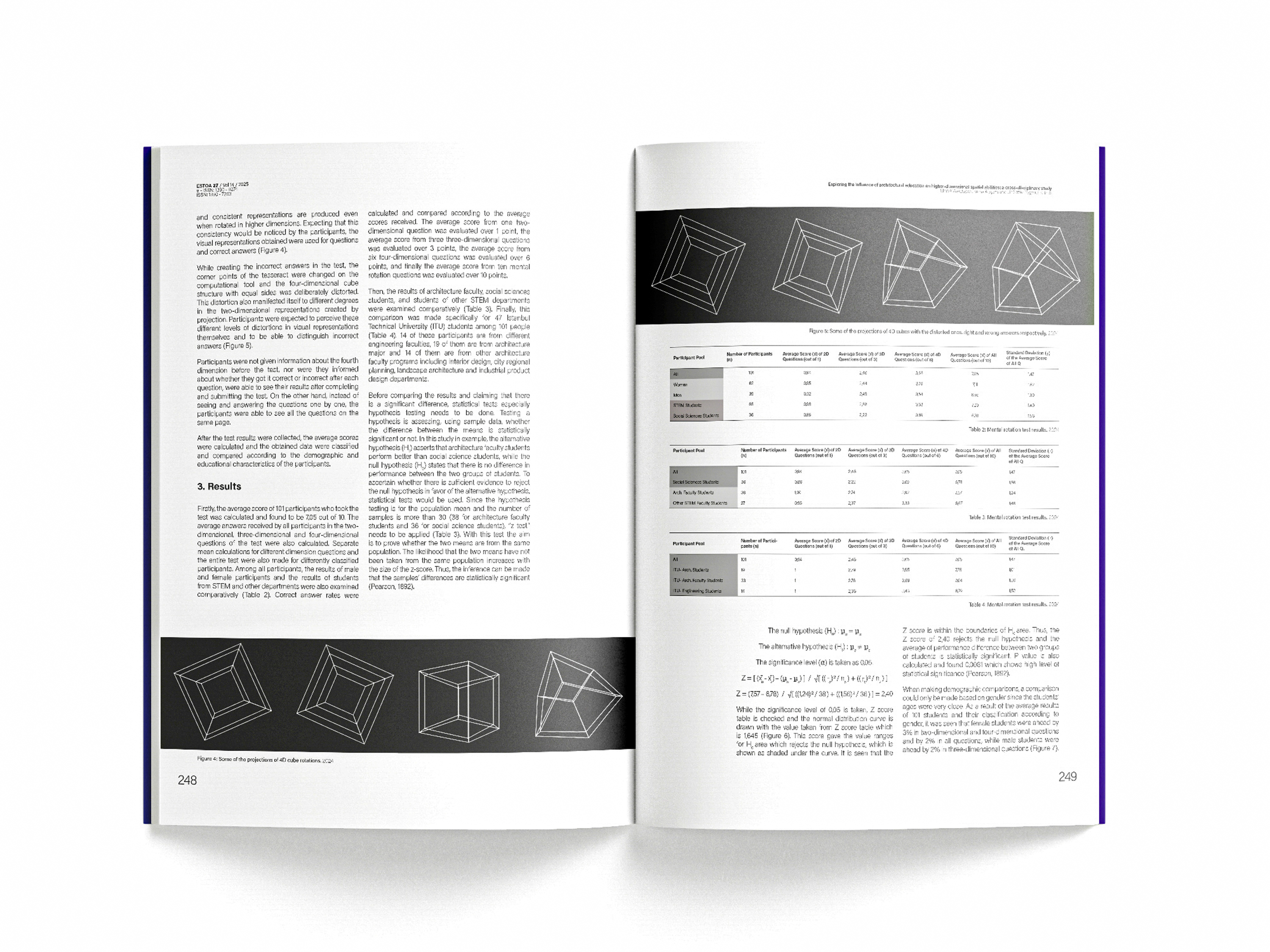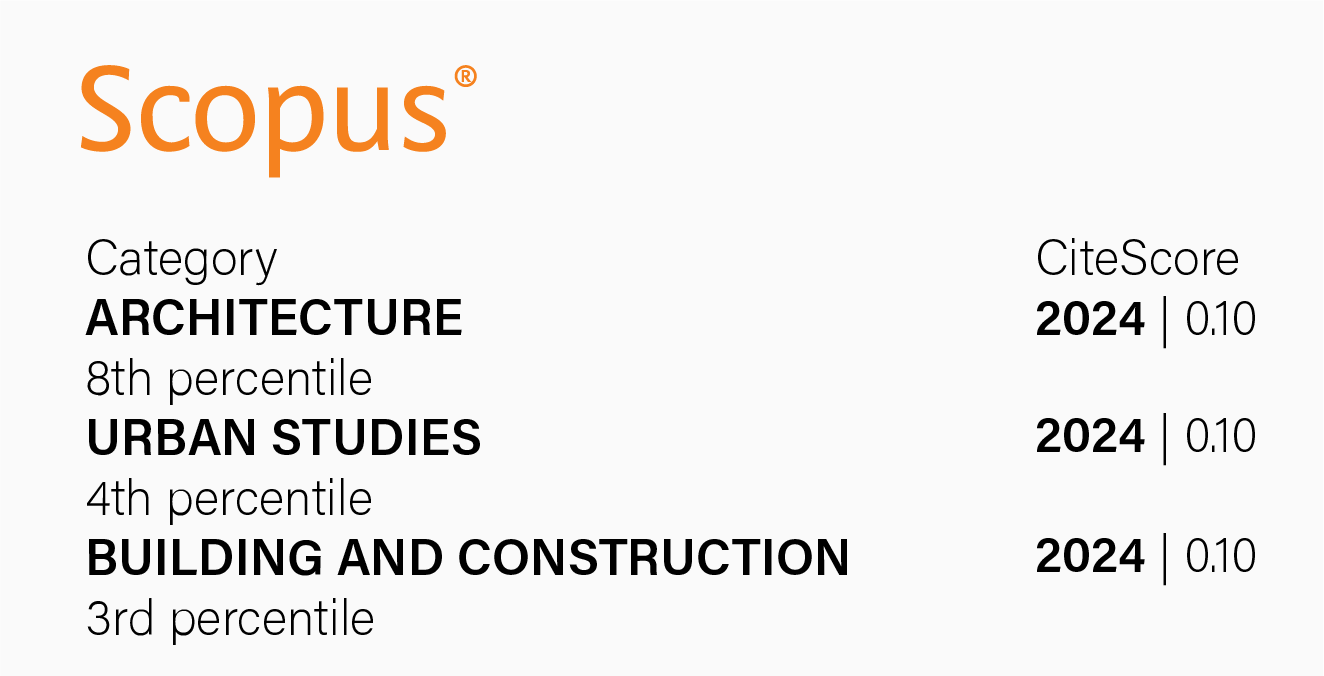Exploring the influence of architectural education on higher-dimensional spatial abilities: a cross-disciplinary study
DOI:
https://doi.org/10.18537/est.v014.n027.a15Keywords:
mental rotation test, visuospatial abilities, architectural education, higher-dimensional geometry, spatial cognitionAbstract
This study investigates the influence of academic discipline on higher-dimensional visuospatial abilities among undergraduate students. Drawing upon a diverse sample from multiple universities and BSc programs, the research examines the performance of architecture, engineering, and social sciences students on a novel nD cube mental rotation task. A total of 101 participants engaged in an online test involving the visualization and interpretation of two-dimensional, three-dimensional and four-dimensional geometries projected onto two-dimensional planes. Results indicate a difference in performance between architecture students and other students, with architecture students demonstrating higher accuracy in predicting nD cube rotations. These findings suggest that architectural education may enhance visuospatial abilities, potentially due to its emphasis on spatial cognition and representation throughout the curriculum. Further research with more comprehensive tests and broad participation is needed to explore the longitudinal effects of educational interventions and the potential for interdisciplinary collaboration to foster cognitive development among undergraduate students.
Downloads
References
Akdoğan, M. (2019). A computational approach to create aperiodic tilings through orthographic projection of the nd cube (Master’s thesis, Fen Bilimleri Enstitüsü).
Akın, Ö. (2003). Spatial reasoning of architecture students with simple three-dimensional arrangements. ITU Journal Series A: Architecture, Planning, Design, 1(1), 3-19.
Ambinder, M. S., Wang, R. F., Crowell, J. A., Francis, G. K., & Brinkmann, P. (2009). Human four-dimensional spatial intuition in virtual reality. Psychonomic bulletin and review, 16, 818-823.
Arslan, A. R. & Dazkir, S. S. (2017). Technical drafting and mental visualization in interior architecture education. International Journal for the Scholarship of Teaching and Learning, 11(2), 15.
Berkowitz, M., Gerber, A., Thurn, C. M., Emo, B., Hoelscher, C., & Stern, E. (2021). Spatial abilities for architecture: Cross sectional and longitudinal assessment with novel and existing spatial ability tests. Frontiers in Psychology, 12, 587.
Campos-Juanatey, D., Pérez-Fabello, M. J., & Campos, A. (2017a). Differences in image rotation between undergraduates from different university degrees. Cognitive Processing, 18(4), 413-421.
Campos-Juanatey, D., Tarrío, S., Dopico, J. A., & Campos, A. (2017b). Ability of architecture students to rotate urban maps. Cognitive Processing, 18(4), 355-361.
Darwish, M., Kamel, S., & Assem, A. (2023). Extended reality for enhancing spatial ability in architecture design education. Ain Shams Engineering Journal, 14(6), 102104.
Gardner, M. (1966). Mathematical Games: Is It Possible to Visualize a Four-dimensional Figure. Scientific American, 214, 138-143.
Guay, R. (1976). Purdue spatial vizualization test. Educational testing service.
Hegarty, M., & Waller, D. (2005). Individual differences in spatial abilities. Psychological Review, 112(2), 325–334. https://doi.org/10.1037/0033-295X.112.2.325
Hinton, C. H. (1880). What is the fourth dimension?. The University magazine, 1878-1880, 1(1), 15-34.
Kara, I. (2020). The role of spatial ability on architecture education. Journal of Architectural Education Research, 7(2), 56-67.
Liben, L. S. (2007). Education for spatial thinking. Handbook of child psychology, 4.
Miwa, T., Sakai, Y., and Hashimoto, S. (2017). Learning 4-D spatial representations through perceptual experience with hypercubes. IEEE Transactions on Cognitive and Developmental Systems, 10(2), 250-266.
Moreau, D., Mansy-Dannay, A., Clerc, J., & Guerrien, A. (2010). Academic program and mental rotation performance: Evidence for a developmental effect on individual differences in early adulthood. Cognitive Development, 25(2), 127-137.
Mostafa, M., & Mostafa, H. (2010). How do architects think? Learning styles and architectural education. ArchNet-IJAR: International Journal of Architectural Research, 4(2/3), 310.
Pearson, K. (1892). The grammar of science. Nature, 46(1185), 247-247.
Sorby, S. A. (2009). Educational research in developing 3-D spatial skills for engineering students. International Journal of Science Education, 31(3), 459-480. https://doi.org/10.1080/09500690802595839
Shepard, R. N., & Metzler, J. (1971). Mental rotation of three-dimensional objects. Science, 171(3972), 701-703. https://doi.org/10.1126/science.171.3972.701
Turgut, M. (2015). Individual Differences in the Mental Rotation Skills of Turkish Prospective Teachers. Issues in the Undergraduate Mathematics Preparation of School Teachers, 5.
Vandenberg, S. G., & Kuse, A. R. (1978). Mental rotations, a group test of three-dimensional spatial visualization. Perceptual and Motor Skills, 47(2), 599-604. https://doi.org/10.2466/pms.1978.47.2.599
von Károlyi, C. (2013). From Tesla to Tetris: Mental rotation, vocation, and gifted education. Journal of Spatial Cognition, 9(2), 125-134.
Vorstenbosch, M. A., Klaassen, T. P., Donders, A. R. T., Kooloos, J. G., Bolhuis, S. M., & Laan, R. F. (2013). Learning anatomy enhances spatial ability. Anatomical sciences education, 6(4), 257-262.
Wang, R. F. (2014). Human four-dimensional spatial judgments of hyper-volume. Spatial Cognition and Computation, 14(2), 91-113.
Yagmur-Kilimci, E. S. (2010). three-dimensional mental visualization in architectural design. https://www.researchgate.net/publication/50252912_3d_mental_visualization_in_architectural_design
Zhu, C., Leung, C. O. Y., Lagoudaki, E., Velho, M., Segura-Caballero, N., Jolles, D. & Klapwijk, R. (2023, April). Fostering spatial ability development in and for authentic STEM learning. In Frontiers in Education (Vol. 8, p. 1138607). Frontiers Media SA.

Published
How to Cite
Issue
Section
License
Copyright (c) 2024 Estoa. Journal of the Faculty of Architecture and Urbanism

This work is licensed under a Creative Commons Attribution-NonCommercial-ShareAlike 4.0 International License.
The Journal declines any responsibility for possible conflicts derived from the authorship of the works that are published in it.
The University of Cuenca in Ecuador conserves the patrimonial rights (copyright) of the published works and will favor the reuse of the same ones, these can be: copy, use, diffuse, transmit and expose publicly.
Unless otherwise indicated, all contents of the electronic edition are distributed under a Creative Commons Attribution-NonCommercial-ShareAlike 4.0 International License.



